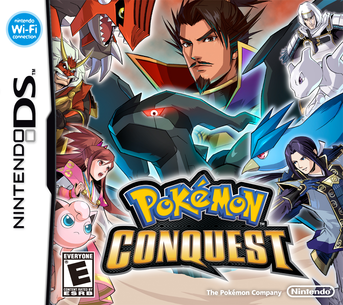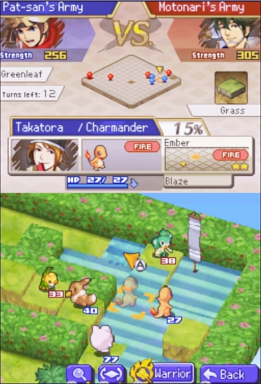Pokémon Conquest facts for kids
Quick facts for kids Pokémon Conquest |
|
|---|---|

North American box art
|
|
| Developer(s) | Tecmo Koei |
| Publisher(s) | |
| Director(s) | Osamu Mieda |
| Producer(s) | Hisashi Koinuma Toshio Miyahara Takato Utsunomiya |
| Designer(s) | Yukinori Ito |
| Programmer(s) | Hideomi Chino |
| Composer(s) | Shinichiro Nakamura |
| Series | Pokémon Nobunaga's Ambition |
| Platform(s) | Nintendo DS |
| Release date(s) |
|
| Genre(s) | Tactical role-playing game |
| Mode(s) | Single-player, multiplayer |
Pokémon Conquest is a fun strategy game released in 2012 for the Nintendo DS. In Japan, it's known as Pokémon + Nobunaga's Ambition. This game is special because it brings together two popular video game series: Pokémon and Nobunaga's Ambition. It was created by Tecmo Koei and published by The Pokémon Company and Nintendo.
Contents
How to Play Pokémon Conquest
Pokémon Conquest is a tactical role-playing game, which means battles happen on a grid, and you move your characters like pieces on a board. This is different from the main Pokémon games where battles are usually one-on-one.
Your Adventure in Ransei
You play as a young hero or heroine, and your journey begins in the Ransei Region. Your goal is to explore this region, make friends with Pokémon, and battle against other powerful leaders called Warriors and Warlords. When you defeat them, they might join your team, letting you use their Pokémon too!
Battles and Pokémon Moves
In battles, your Pokémon can only use one special move. This move is usually chosen to fit that Pokémon's unique abilities. For example, Excadrill uses its signature move, Drill Run. Unlike the main Pokémon games, not all 649 Pokémon from that time are in Pokémon Conquest.
Catching Pokémon and "Link"
Instead of catching Pokémon with Poké Balls, you play a mini-game. Your Warrior tries to form a "link" with a wild Pokémon by pressing buttons at the right time, a bit like a rhythm game.
The usual leveling system is replaced by a "link" percentage. This percentage shows how strong your Pokémon is and how well it's connected to its Warrior. The higher the link, the better your Pokémon's stats will be in battle. Each Warrior has a favorite type of Pokémon, which helps them form a stronger link with those Pokémon. Some Warlords can even form perfect links with legendary Pokémon!
Evolving Pokémon and Warlords
Pokémon in this game evolve differently. They don't just reach a certain level. Instead, they evolve when they meet specific conditions, like reaching a certain link percentage or winning a battle in a particular kingdom. Warlords can also evolve, but usually only after you finish the main story. Their outfits often look like the Pokémon they have a perfect link with!
After the Main Story
After you defeat the main bad guy, Nobunaga, and finish the main story, there are 36 special episodes you can play. Each episode features a different Warlord and has new goals, like taking over only a part of Ransei. The computer players become smarter, and you can upgrade locations in the region to find more Pokémon or better items. These episodes sometimes refer to real historical events from Japan.
The Story of Ransei
A long time ago, a legend said that whoever united all 17 kingdoms of the Ransei Region would meet a Legendary Pokémon that created the region. This legend made many Warriors and Warlords start fighting each other, ending Ransei's peaceful time.
Starting Your Journey
Your adventure begins when you become the Warlord of the Aurora kingdom. Soon, you meet Oichi, who explains that other kingdoms are fighting to fulfill the Ransei Legend. You start your journey by uniting the nearby kingdom of Ignis, hoping to bring peace back to Ransei.
Facing Nobunaga
As you conquer more kingdoms like Greenleaf, Fontaine, Violight, Chrysalia, and Pugilis, Oichi tells you about Nobunaga. He lives in the northern part of Ransei and is the biggest threat. Nobunaga wants to fulfill the Ransei Legend and use the power of the Legendary Pokémon Arceus to destroy Ransei.
The Final Showdown
After you conquer more kingdoms and recruit powerful Warlords like Shingen and Kenshin, Nobunaga confronts you. He controls many kingdoms and warns you not to oppose him. You eventually face Nobunaga and his powerful Zekrom.
Once Nobunaga is defeated, you unite Ransei, and a special place called the Infinity Tower appears. Inside, you find the Mythical Pokémon Arceus. After you form a link with Arceus, Nobunaga returns for a final battle, this time with a shiny Rayquaza and his strongest allies.
After this last battle, Nobunaga reveals his true plan: he wanted to destroy Arceus because he believed it was the cause of all the fighting in Ransei. However, seeing that you are not affected by linking with Arceus, and as Arceus leaves, Nobunaga gives up. Peace returns to Ransei, and the kingdoms go back to their rightful owners.
How the Game Was Made
Pokémon + Nobunaga's Ambition was first announced at a big anime and manga event in Japan called "Jump Festa" on December 17, 2011. Nintendo and Tecmo Koei shared the news and said the game would come out in 2012.
Later, on April 4, 2012, it was announced that the game would be released in the United States on June 18, 2012, under the name Pokémon Conquest. Some of the people who designed the human characters also worked on another game called Samurai Warriors 3.
See also
 In Spanish: Pokémon Conquest para niños
In Spanish: Pokémon Conquest para niños


